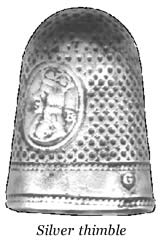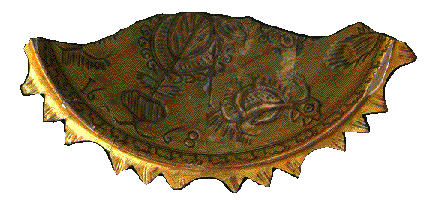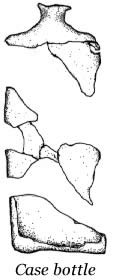Uncovering Traces of Historic Kecoughtan
Archaeology at a 17th-Century Trading Plantation Site in the City of Hampton, Virginia
Supported by: Virginia Department of Transportation and The City of Hampton
The William & Mary Center for Archaeological Research, through the support of the Virginia Department of Transportation (VDOT) and the City of Hampton, conducted an intensive archaeological excavation at Site 44HT44 in the fall and winter of 1996/1997. Preliminary work in 1994, also sponsored by VDOT and the City of Hampton, identified the first evidence of a seventeenth-century plantation at this site. Extensive archaeological excavation was eventually determined necessary to recover information prior to construction of the City Satellite Parking Lot adjacent to the Pentran Transportation Center. This latest study investigated traces of the colonial occupation at the site and revealed details of plantation life not available in the historical record.
 Site 44HT44, situated near the heart of downtown Hampton, is closely linked to the seventeenth-century settlement of Kecoughtan. In 1607, the Native American village of Kecoughtan stood amid a few thousand cleared acres on the east side of the mouth of the Hampton River. When the first English settlers arrived, the great chief Powhatan had only recently extended his influence over the ancient town. Powhatan had forcibly taken control of the village and repopulated it with a small, loyal community of subjects from his confederation. Relations with Native Americans deteriorated soon after the English began to settle the region. In 1610, Governor Thomas Gates removed the Powhatan settlers from the village. Centuries of Native American occupation at Kecoughtan came to an end.
Site 44HT44, situated near the heart of downtown Hampton, is closely linked to the seventeenth-century settlement of Kecoughtan. In 1607, the Native American village of Kecoughtan stood amid a few thousand cleared acres on the east side of the mouth of the Hampton River. When the first English settlers arrived, the great chief Powhatan had only recently extended his influence over the ancient town. Powhatan had forcibly taken control of the village and repopulated it with a small, loyal community of subjects from his confederation. Relations with Native Americans deteriorated soon after the English began to settle the region. In 1610, Governor Thomas Gates removed the Powhatan settlers from the village. Centuries of Native American occupation at Kecoughtan came to an end.
By 1616, there were about 20 English inhabitants at Kecoughtan, and most were engaged in farming. In 1619, Kecoughtan's first two representatives in the House of Burgesses were Captain William Tucker and William Capps. Tucker was the military commander of Kecoughtan and Capps an early landowner on the west side of the Hampton River. At the first session of the legislature, the two men petitioned the Assembly "to change the savage name of Kicowtan, and to give that Incorporation a new name." In 1620, the name "Elizabeth City" was adopted, and it served as the county's name until 1952.

 Despite this early change, the place name "Kecoughtan" has been employed variously and has survived down to the present day. During the period between 1620 and the founding of the town of Hampton in the 1690s, the name "Kecoughtan" seems to have referred to the scatter of waterfront plantations and trading establishments along the Hampton River. Site 44HT44, occupied during the mid- to late 17th century, was one of these plantations. Historical research has hinted that the site once belonged to William Claiborne, who served as treasurer and secretary of state of the colony, and later to ship captain Thomas Jarvis.
Despite this early change, the place name "Kecoughtan" has been employed variously and has survived down to the present day. During the period between 1620 and the founding of the town of Hampton in the 1690s, the name "Kecoughtan" seems to have referred to the scatter of waterfront plantations and trading establishments along the Hampton River. Site 44HT44, occupied during the mid- to late 17th century, was one of these plantations. Historical research has hinted that the site once belonged to William Claiborne, who served as treasurer and secretary of state of the colony, and later to ship captain Thomas Jarvis.
Historical information about Claiborne's possible occupation at Site 44HT44 is sparse. Research suggests that Claiborne may have owned the property as early as 1624. The site may have been part of his 150-acre Kecoughtan plantation from which he operated a successful trading venture. By 1630, Claiborne was one of the 10 largest tobacco exporters in the colony. He was one of a handful of men who sought new enterprises outside of tobacco cultivation, namely, trade with Native Americans in the Chesapeake region.
Claiborne may have lived at the site until 1661, when he moved to a new plantation on the Pamunkey River near what is now West Point. It is not known who might have purchased Claiborne's 150-acre plantation; however, 20 years later, in 1680, Thomas Jarvis owned a 200-acre "trading plantation" that probably included most, if not all, of the old Claiborne property and surrounding lands. It is from this plantation land that the town of Hampton emerged near the end of the 17th century.

Archaeology is revealing the plantation's organization and evolution, architecture, and the socioeconomic status of its occupants. The clues unearthed document aspects of early colonial life that are rarely preserved in written records. For instance, the archaeology has revealed extensive remains of post buildings, fencelines, trash pits, and a stone-lined well. The arrangement of these features reflects yard areas around possible dwellings and outbuildings. The buildings were constructed in a common fashion for the period: framed with large, evenly spaced posts set into the ground. The dwellings most likely had chimneys of daub (a mixture of clay and straw) applied to a stick frame; however, traces of these features have long since been plowed away. Many of the trash pits may have originally been dug for clay to make daub and bricks.
The features discovered at Site 44HT44 indicate that modifications were made to the plantation over time. Several of the buildings were built over the former locations of fencelines. Evidence of the structures' posts, as revealed by the excavated postholes, suggests repair and replacement, and indicates fairly intensive, long-term occupation of the site.
 Many of the features and deposits such as the well, trash pits, and postholes were excavated, yielding thousands of artifacts. These include a portion of an English slipware bowl dated 1668; Portuguese tin-glazed earthenware; a letter seal with the initials "TCN"; part of an iron wall sconce; Venetian glass tableware fragments; Dutch, English, and locally made tobacco pipes; fragments of iron hoes and shovels; a thimble engraved with the profile of King Charles II; and a wide variety of other domestic and agricultural artifacts. The artifacts reflect significant wealth that few Virginians possessed during the seventeenth century.
Many of the features and deposits such as the well, trash pits, and postholes were excavated, yielding thousands of artifacts. These include a portion of an English slipware bowl dated 1668; Portuguese tin-glazed earthenware; a letter seal with the initials "TCN"; part of an iron wall sconce; Venetian glass tableware fragments; Dutch, English, and locally made tobacco pipes; fragments of iron hoes and shovels; a thimble engraved with the profile of King Charles II; and a wide variety of other domestic and agricultural artifacts. The artifacts reflect significant wealth that few Virginians possessed during the seventeenth century.
Sites like 44HT44 demonstrate the potential of archaeology to complement and expand the historical record. The study has enhanced our understanding of 17th-century settlement in Virginia, providing a rare glimpse of early plantation life on land that would become the City of Hampton.
Using the results of the excavation, a more complete history of the site has been written with information provided by laboratory analysis of the artifacts. The excavation records and artifacts recovered from Site 44HT44 will become part of the City of Hampton's museum collection, housed in the Charles Taylor Art Center, where they will be available for research, public education, and exhibition.
We wish to thank VDOT and the City of Hampton for their patience, interest, and assistance throughout this project.
A complete report of research at the Pentran Site is available as CAR's Technical Report Series No. 28.
Suggested Readings
Deetz, James
1977 In Small Things Forgotten: The Archeology of Early American Life . Anchor Press/Doubleday, Garden City, New York.
Higgins, Thomas F. III, et al.
1993 The Evolution of a Tidewater Town: Phase III Data Recovery at Sites 44HT38 and 44HT39, City of Hampton, Virginia. Technical Report Series No. 12. William & Mary Center for Archaeological Research. Williamsburg, Virginia. Submitted to Virginia Department of Transportation, Richmond.
Traces of Historic Kecoughtan: Archaeology at a Seventeenth-Century Plantation: Data Recovery at Site 44HT44, Associated with the Proposed Pentran Bus Parking Lot Project, City of Hampton, Virginia. Technical Report Series No. 28. William & Mary Center for Archaeological Research. Williamsburg, Virginia. Submitted to Virginia Department of Transportation, Richmond.
Horn, James
1994 Adapting to a New World: English Society in the Seventeenth-Century Chesapeake . Published for the Institute of Early American History and Culture, Williamsburg, Virginia, by the University of North Carolina Press, Chapel Hill.
Samford, Patricia, and David L. Ribblett
1995 Archaeology for Young Explorers: Uncovering History at Colonial Williamsburg. Colonial Williamsburg Foundation, Williamsburg, Virginia.
For More Information Contact
Joe B. Jones
William & Mary Center for Archaeological Research
Phone: 757-221-1581
Email: [[jbjone, jbjone@wm.edu]]















